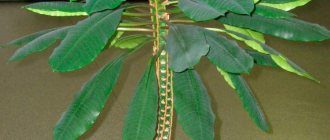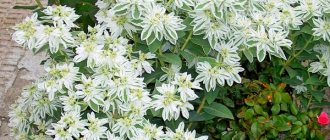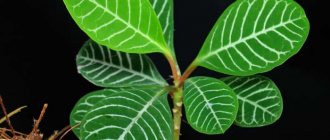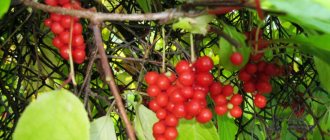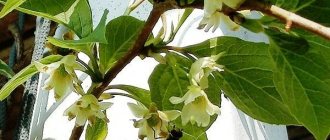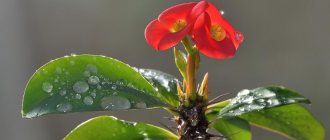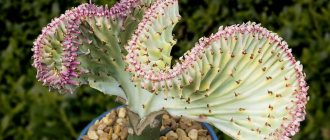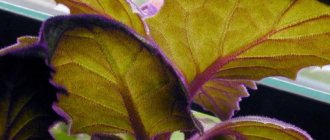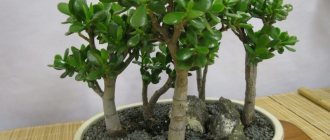Beautiful and unapproachable “Africans”
Spurge
or
euphorbia (Euphorbia)
is a large genus of plants of the Euphorbiaceae family, living in various climatic conditions and numbering about 2000 species of monoecious and dioecious plants. These are herbaceous plants, subshrubs, shrubs and trees, succulents, very similar to cacti. By the way, among succulents, milkweeds rank third in number - approximately 290 species.
Euphorbia its name to the physician Euphorbus, who was the first to determine the medicinal properties of the milkweed Euphorbia resinifera, from whose milky juice medicine was made for a long time. Most succulent milkweeds come from South Africa, Ethiopia, Congo, and the island of Madagascar. There they are planted along houses as hedges. Thorny bushes with thin branches or ribbed, erect shoots grow up to 10 m and serve both as protection and decoration of the home. In indoor floriculture, milkweeds, of course, do not reach such sizes. A characteristic feature of all euphorbias is milky sap, which is released abundantly at the slightest damage to the plant. The juice contains rubber, resins, amino acids, stearin, essential oils, saponins, and sugars. There is also a toxic substance - euphorin, which can cause burns, inflammation of the mucous membranes of the eyes, nose, and dysfunction of the gastrointestinal tract. Therefore, care should always be taken when planting and propagating milkweeds.
Euphorbias produce unisexual flowers consisting of single stamens and pistils without a perianth. Inconspicuous flowers are surrounded by nectar glands or bright leaves. The fruit is a three-lobed capsule with seeds; after ripening, they shoot out of the box in different directions at a distance of up to 1 m and quickly germinate.
Planting and care
Euphorbia is a fairly unpretentious plant to care for. Loves sandy soils intended for succulents and cacti. The optimal ratio of sand, leaf soil and turf for milkweed is 2/2/3. A mixture of sand, turf and peat in equal proportions is also suitable. Drainage is required.
Euphorbia is transplanted in the spring. If the plant was purchased at another time of the year, it is better not to replant. A young plant can be replanted annually, and a mature one once every 2-3 years.
Feeding milkweed is done no more than once a month and only during the warm period. Mineral fertilizers for succulents or cacti are suitable for nutrition. The fertilizer concentration must be reduced by 2 times.
Euphorbia is a sun-loving plant and does not like drafts. In the summer, plants can be taken outside or onto the balcony. Euphorbia tolerates temperature drops down to +8. There are varieties that prefer direct sunlight, while others prefer partial shade. If you place the spurge correctly, it will delight you with its beautiful appearance. Sun-loving varieties can exist in the shade, but the lack of sun will affect the color of the leaves. In summer, plants can be taken out into the fresh air.
You can water euphorbia once a week in summer, and once a month in winter. This plant does not like excess moisture and is prone to rotting of the root system. If the soil is dry, then restore the moisture gradually; sudden, abundant watering will negatively affect the condition of the milkweed.
Most types of milkweed are disease resistant and do not attract pests. Of the parasites, spurge can attract scale insects. If this happens, you need to treat the plant with an insecticide.
Euphorbia white-veined, or Just Euphorbia
Euphorbia alba is probably the most popular type of indoor milkweed.
The name euphorbia was given in honor of the physician Euphorbia, who discovered the beneficial properties of the milky juice of this plant. I have an ambivalent attitude towards milkweed (as do all my friends). On the one hand, there are interesting leaves, an unusual appearance, either a palm tree or a cactus, unpretentious. On the other hand, if you don’t like something, the leaves turn yellow, the trunk becomes bare and three tufted leaves remain on the top of the head.)) But I’ve had it in my collection of succulents (at work and at home) for many, many years. Euphorbia white-veined (at work)
Description of the plant
Euphorbia albiginata is a type of deciduous succulent.
It has a ribbed trunk, which in nature reaches 1.5 m, and at home from 0.5 to 1 meter in height. At the end of the trunk there are small thorns, which is why euphorbia is sometimes confused with cacti. The leaves are oval, with white veins, which appear to be painted with white paint along the top of the leaf and are located in the upper part of the trunk. The veins of a young plant are especially clearly visible. Young euphorbia at work Because of this arrangement of leaves, euphorbia is sometimes called a palm tree. Over time, the lower leaves die off and the trunk becomes like a club with thorns along its entire length. Sometimes shoots may appear on it, and the spurge becomes branched. Euphorbia blooms with small white-brown inconspicuous flowers, collected in inflorescences.
Flowering The fruit of milkweed is a capsule, which, when ripe, shoots out seeds, and then a lot of new milkweed shoots appear in the pot, since the survival rate of the seeds is very high.
Growing conditions
Loves
- bright rooms
- warm (20-25°C)
Does not love
- drafts
- drying out of the soil
Planting, transplanting and propagation
It is recommended to replant euphorbia annually.
I replant the plant only when I see that it is becoming crowded in a given pot or the base of the trunk is becoming “woody” and thinning. I carefully dig up the flower and transplant it into a larger pot. I pour expanded clay onto the bottom of the pot, and on top there is a mixture of leaf and turf soil with a large addition of sand. You can use a mixture for succulents. I deepen the plant, that is, I try to sprinkle earth on the woody part of the trunk. The lower part of the trunk becomes thinner and woodier. It's time to replant. The plant takes root well, and when basal shoots appear on it, the trunk begins to branch.
Either a palm tree or a cactus (at home)
Euphorbia reproduces by seeds that appear after flowering. If you have one flower, wait, soon there will be a lot of them!!! The seeds germinate two weeks after sowing, and sometimes euphorbia sprouts can be found in neighboring pots.))) At first these are small leaves, which after two to three weeks become like a mini-palm tree. I usually leave the shoots in “good hands”, but often I just pull them out and weed them. Because if you don’t get rid of excess sprouts, a landscape of Madagascar or South Africa, the homeland of this succulent, may appear on the windowsill. Euphorbia is also propagated by cuttings, but I have never used this method.
Watering and fertilizing
Euphorbia, although a plant of arid regions, is very demanding when it comes to watering.
In summer it needs to be watered very abundantly. If it lacks moisture, the leaves begin to turn yellow and crumble. It is better to take the plant out into the open air in the summer, if possible, but so that the euphorbia does not get exposed to rain. In this case, rot may appear on the leaves. In winter, spurge should be watered moderately, after the soil has dried 2-3 cm. The temperature should not be high (preferably no higher than 20°C). It is recommended to feed euphorbia with liquid bird droppings, but in apartment conditions, simply use liquid fertilizer for succulents.
Interesting Facts
Something to remember! Euphorbia is a poisonous plant. Its milky sap can cause burns and allergies, and if large quantities enter the body, it can cause poisoning. The plant should be kept away from children and animals. Despite many contraindications, in the homeland of this plant it is used for medicinal purposes: to make honey (rich in B vitamins, iron, iodine), to treat eczema and dermatitis, dysentery and gastrointestinal diseases. But it’s there... in Madagascar and South Africa.))) For us, it’s just a cute succulent that I like, and which enlivens the interior at work and at home.
Reproduction
Euphorbia reproduces quite easily. Most often propagated by cuttings, but there are species (for example, white-veined) that are good to grow from seeds. Globular species of euphorbia are also propagated by seeds.
- We propagate by seeds. Milkweed seeds are in a capsule that ripens and cracks. To collect the seeds, place a fabric bag over the box. After collection, the seeds are dried on paper. For germination you need to purchase a sand-peat mixture. Plants are sown in separate pots. In order not to expose young shoots to infection, the soil must be disinfected and you should not sow euphorbia with other plants. The pot is placed in a dark place until shoots emerge.
- Propagation by cuttings. Good healthy shoots are suitable for propagation by cuttings. The lower part of the branch is cleared of leaves, washed of juice, wiped dry with a cloth, the cut is dipped in ash and dried for a couple of days. Then planted in moist soil. The pot is kept away from direct sunlight.
All types of milkweed are easily propagated, you just need to choose the right method.
Reproduction and transplantation
Reproduction of deciduous forms is carried out by cuttings of shoots or seed. Milkweed seeds sprout quickly and very quickly; the sprouts do not require special care. In the absence of flowering, such species can be propagated by rooting small shoots cut from the bush. Several rules for cutting euphorbia:
- You need to wash off the milky juice from the cut;
- you should wait for the damaged tissue to dry;
- if possible, dip the cuttings in a rooting agent;
- place the shoot in a loose, moist substrate up to halfway;
- arrange a mini-greenhouse by covering the plant with a glass vessel or film.
Once the shoot begins to grow, it will not need special conditions.
There are no difficulties with the reproduction of cactus-like species. Most often, “babies” appear on an adult stem - fully formed small plants that quickly take root upon contact with the ground.
Succulents do not like transplants, so the procedure is carried out only in extreme cases. If roots appear from the drainage holes of the pot and the plant has stopped growing, you can replace the container with a larger one. It is easy to replant young plants, but old ones should only be formed and the above-ground parts pinched.
Some vigorous species of milkweed require pruning. For others, removing the tips of the shoots is sufficient. With this method of formation, the stems branch more strongly, but flowering may not occur. White-leaved, ribbed and cactus-shaped plants do not need pinching.
Variety of species
The Euphorbia genus has about 800 species. Among them there are wild and domestic plants. Domestic crops are divided into outdoor and indoor crops. The forms and appearance of plants are so diverse that one can doubt their relationship.
Types of milkweed:
- Triangular spurge. This is one of the most common types. Ease of care and unpretentiousness have made it a frequent guest not only in residential premises, but also in public institutions. The shoots of triangular milkweed are fleshy, thick, and have knobs on the edges. The color is dark green. This species grows very quickly and can reach the ceiling in 4-5 years.
- Poinsettia. This species is also called the Most Beautiful. This spurge has very beautiful leaves. The lower ones are green, and the leaves of the inflorescences can be pink, white or red. The plant blooms with small flowers at the end of December. After flowering, Poinsettia sheds its leaves and loses its attractiveness for several months. This is a very capricious species to care for.
- Resinous spurge. This milkweed looks like a cactus. It looks like a bush of dense shoots. The branches are fleshy, green with four edges. There are small spines on each edge. Quite unpretentious appearance.
- Euphorbia Mile. This milkweed looks like a mini bush. The branches are not so fleshy, with a gray tint and purple spines are located on them. The leaves are green, oblong. It blooms with small bright flowers. Young plants look very pretty, but mature ones have bald branches and look more like a thorn bush.
- White headed spurge. It has a fleshy trunk, at the end of which there is a bunch of leaves. The leaves are large, oblong with white veins. This species blooms frequently and is capable of self-sowing.
- Large-horned spurge. It has a thick triangular stem with huge paired spines. Very often this species is considered a cactus. There are small leaves on the branches, but the plant quickly sheds them. Large-horned spurge blooms with small yellow flowers.
- Milk spurge. It has dense four-rib green branches. The ribs have a white coating in the form of stripes and small paired spines. Leaves appear, but do not develop and immediately dry out.
- Euphorbia Tirukalli. It has smooth green branches, cylindrical in shape. The thickness of the branches is up to 7 mm. The leaves are bright green, straight, falling. Leaf length up to 12 mm.
- Multi-thorned spurge. Has strongly branching shoots. The branches are four-ribed, bright green with a brown edge. On mature parts of branches the ribs are diffuse. Paired gray spines are located along all ribs.
- Schoolleaf spurge. It has powerful trunks reaching 7 cm in diameter. The height of milkweed is up to 25 cm. The trunks are covered with tubercles and outwardly resemble a conifer cone. At the end of the trunk there is a bunch of thin long leaves.
Types of euphorbia with photos and names
Beautiful spurge (Euphorbia pulcherrima)
It is also called poinsettia. This is one of the most popular milkweeds that is grown at home. This plant blooms at Christmas (Catholic). However, it is not the small flowers that give the plant its spectacular appearance, but the bright leaves growing under the inflorescences. Depending on the variety, these leaves can be colored pink, deep red, or white. If the room is too warm and the air humidity is low, then with the end of flowering, all the leaves of the plant fall off. This species is quite demanding in terms of care.
Euphorbia resinifera
This plant is cactus-like and has tetrahedral green-gray shoots. On the ribs there are warty protrusions on which there are spines. This is a very unpretentious plant.
Euphorbia hypericifolia (Euphorbia hypericifolia)
Also called “Diamond Frost”, this non-capricious plant is very loved by gardeners. It is usually planted in hanging baskets. On the cap of pale green leaves there are many small white flowers, which are very similar to snow-white foam.
Milkweed (Euphorbia milii)
This not very large thorny bush is also called the “crown of thorns”. Its gray powerful shoots bear oblong leaves. The young shrub is very beautiful, as it bears many small flowers with rich red or pale yellow bracts that contrast with the dark green foliage. The old plant becomes similar to a thorny dry bush. Feels great near a window located in the southern part of the room.
Euphorbia obesa (Euphorbia obesa)
This succulent plant is very similar to a cactus. It has a stem in the shape of a ball, on which there are faintly pronounced ribs. It has no leaves or spines.
Euphorbia grandicornis
It has a rather bizarre shape. Its branching, fleshy stems are triangular. At the edges there are large gray or brownish-yellow spines. The leaves grow on young shoots and fly off pretty soon.
Euphorbia trigona
This rather spectacular tall plant has triangular branching stems. Leaves, which have an oblong shape, grow at the ends of young stems. After some time, the leaves fall off.
Euphorbia tirucalli
This succulent plant requires little care. The shoots of this very bushy milkweed look like small green sticks. It lacks both spines and leaves.
